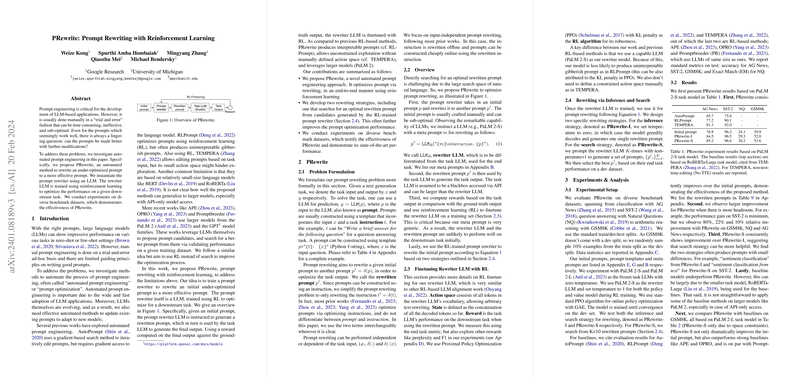Insightful Overview of "PRewrite: Prompt Rewriting with Reinforcement Learning"
The paper "PRewrite: Prompt Rewriting with Reinforcement Learning" introduces an innovative approach to address the challenges associated with manual prompt engineering in LLMs. The proposed method, PRewrite, leverages an automated framework that utilizes reinforcement learning (RL) to rewrite and optimize prompts for various downstream tasks, thus alleviating the iterative and manual nature of traditional prompt engineering.
Motivation and Challenges in Prompt Engineering
Prompt engineering is integral to optimizing the performance of LLMs for specific tasks. Typically, this process involves manually crafting prompts in a trial-and-error manner, which is often sub-optimal and time-consuming. One persistent question remains: can these prompts be further refined to enhance performance? PRewrite aims to automate this process by utilizing an LLM-based prompt rewriter trained through RL, seeking to improve upon benchmarks across diverse datasets and tasks.
Methodological Contributions
PRewrite distinguishes itself through several methodological innovations:
- LLM-Based Prompt Rewriter: The method employs an LLM as a prompt rewriter, utilizing RL to fine-tune its rewriting capabilities. This approach contrasts with previous solutions like AutoPrompt and RLPrompt, which either required gradient access or produced non-interpretable outputs.
- End-to-End RL Optimization: By training the rewriter LLM with RL, PRewrite enhances the ability to generate effective rewritten prompts directly contributing to improved task performance. The use of a larger LLM such as PaLM 2 enhances this capability.
- Rewriting Strategies: Two distinct strategies, PRewrite-I (inference) and PRewrite-S (search), are developed. PRewrite-S further optimizes performance by selecting the best rewritten prompts from various candidates.
Experimental Validation
Extensive experiments demonstrate PRewrite’s efficacy across several benchmark datasets including AG News, SST-2, Natural Questions, and GSM8K. Key findings include:
- Strong improvements over initial prompts in performance metrics, particularly noticeable in tasks where there was more room for enhancement.
- PRewrite-S generally outperforms PRewrite-I, highlighting the benefits of allowing broader exploratory search via generated candidate prompts.
While comparisons with prior methods such as TEMPERA and AutoPrompt are challenged by model size differences, PRewrite’s flexible application to API-only models without gradient access underscores its robustness in a practical setting.
Practical and Theoretical Implications
The practical implications of PRewrite are significant. By automating the prompt optimization process, it paves the way for more efficient deployment and fine-tuning of LLM applications in real-world scenarios. This automation becomes increasingly crucial as LLMs are rapidly integrated into diverse applications requiring continual adaptation and optimization. The theoretical contributions also extend to the broader field of reinforcement learning, showcasing its utility in optimizing natural language inputs in tandem with modern neural architectures.
Future Directions
The paper leaves several avenues open for future exploration. Investigating the application of PRewrite across more datasets and initial-meta prompt combinations could yield further insights into its generality and effective tailoring. Additionally, embracing multiple meta prompts to enhance exploration could lead to even greater improvements. Experimental validation of PRewrite on other LLM architectures beyond PaLM 2 would further substantiate its broad applicability.
In conclusion, PRewrite presents a compelling automated approach to prompt engineering, contributing meaningfully to advancements in LLM application efficiency and reinforcement learning methodologies.
